One of the maxims of surface mining is
that haul trucks and mine utility vehicles
don’t mix—as observed by the author
during a stint many years ago at the
Chingola open-pit mine in Zambia:
“There are few sights more disconcerting
than looking in a pickup’s rear-view mirror,
and only being able to see the tread
pattern on the front tire of a haul truck
immediately behind you.”
As the size difference between the
two types of vehicles has progressively increased,
so has the potential for the driver
of one vehicle not to see the other. And
while the opportunity for the operator of a
55-ton truck to miss seeing a pickup is
much less than for, say, his counterpart in
a 300-tonner truck, he can still be completely
unaware of the presence of a pedestrian
until it is too late. It has happened.
And, of course, the problem is not just
one of size. As is recounted later in the
article, an incorrectly spotted truck can
cause major damage to a shovel—when
two large machines collide, the repair bill
can be substantial. In fact, poor visibility
from the cab on any piece of mining
equipment increases the risk for some
sort of collision, as the operator is basically
“flying blind” when it comes to
making certain maneuvers—such as driving
straight ahead.
Most surface mines operate under
strict safety codes that have the aim of
protecting drivers and operators of vehicles
of all sizes. The use of whip pennants on utility vehicles has been commonplace
for decades, providing a highlevel
visual signal to the haul-truck operators
of the presence of something much
smaller, and more vulnerable, that could
be out of their line of sight.
 Cat Detect camera and radar units installed on the side of a 777G haul truck give the operator better ‘visibility.’
Cat Detect camera and radar units installed on the side of a 777G haul truck give the operator better ‘visibility.’
Yet even such visual markers can fail,
as happened in April 2008 at Albian
Sands’ Muskeg River mine in northern
Alberta. An empty hauler ran over an electrician’s
pickup—fitted with both a buggy
whip and a flashing light—at an intersection,
with the hauler operator unaware of
the accident until notified about what had
happened. The pickup driver died.
The investigation by Alberta’s Occupational
Health and Safety authorities cited
a number of factors that contributed to
the accident. The blind areas from the
hauler operator’s position was one. Heavy
site radio traffic meant that the truck
operator did not hear a message sent by
the electrician. The pickup was stopped
at the intersection, but was too close to
the haul road edge. And the electrician
was driving into the setting sun, which
must have affected his vision to the
extent that he did not see the approaching
hauler when he moved off.
Clearly, visual warnings and the use of
a mandatory safety code for drivers and
operators were insufficient in this particular
case. So, what else could have been
done, and how are today’s mine operators
endeavoring to consign this type of incident
to history?
One answer, as the burgeoning number
of suppliers will confirm, is the use of
proximity detection and collision avoidance
systems—systems that can detect
the presence of another vehicle, or even
a person, in a potentially dangerous position—
and alert the machine operator.
Systems that can effectively overcome
the operator’s blind areas and, with the
increasing adoption of autonomous
haulers, help ensure that each vehicle
stays on its prescribed route.
Autonomy is a Driver
As with its major competitors, Caterpillar
has developed its own collision-avoidance
systems for use on its equipment. Part of
the Detect capability set within the company’s
MineStar system, these are used
in the Command for hauling operating
system for autonomous trucks, and
other autonomous and semi-autonomous
machine-operation systems, such as the
one for drills. Cat noted that Detect
can help to alleviate situations where
machines or vehicles are too close for safe
operation, and can also be configured to
provide information about site conditions
and other assets working in the area.
The system can, of course, be customized
to suit individual applications,
and in its simplest form consists of cameras
and an in-cab display. More sophisticated
versions add radar scanning, while
Proximity Awareness uses medium-precision
GNSS receivers to warn operators of
nearby equipment and light vehicles
whenever the machine is in operation.
Object Detection locates objects in
close proximity to the machine at initial
movement and during slow-speed travel.
As the machine moves toward a detected
object, the display automatically switches
to the camera view where the object is
located. Depending on the proximity, the
operator receives both visual and audible
alarms that increase in frequency as the
distance to the object decreases. Where
several detections occur at once, logic is
built into the system to determine which
is the most critical.
Caterpillar explained that these two
facets provide complementary coverage.
Object Detection alerts the operator if an
object is detected around the machine
during startup or slow-speed operation,
while Proximity Awareness is active
whenever the machine is moving faster.
The net result is that the operator of a
machine that is equipped with all three
Detect levels is aware of the real-time
position of all other reporting assets.
For Object Detection, large trucks are
equipped with eight radars, four cameras
and an in-cab display. Two configurations
are available for small off-highway trucks,
including complete coverage with radars
and cameras on each side, or only front
and rear coverage. For wheel loaders,
wheel dozers and motor graders, Object
Detection is a rear-only system consisting
of a single camera and from one to three
radars, depending on the machine model.
Proximity detection and collision avoidance
are key components of autonomous
truck operation, with Cat now having 793F
units working or on trial at both Fortescue
Metals Group and BHP Billiton iron-ore
mines in Australia. FMG’s plans for its
Solomon operations calls for a progressive
ramp-up to 45 autonomous trucks in the
future, while Cat noted that FMG is using
its Detect and other MineStar system
capability sets across its mobile equipment
fleet, including support equipment
and light vehicles.
The Major Hazards
In his presentation to a proximity detection
and collision avoidance systems
workshop that was held in Sydney,
Australia, in February 2011, Craig
Hoffman, product manager for Collision
Avoidance and Geospatial Systems at GE
Mining Technology in Australia, provided
a list of some of the scenarios that can
present hazards during normal surfacemine
operations. They include:
• Heavy vehicle take-off operations with
other vehicles or personnel on the
ground in the path of travel;
• Heavy vehicle reversing operations with
other vehicles, personnel or stationary
objects in the path of travel;
• Light vehicles overtaking heavy trucks
on a haul road;
• Reversing into a dump;
• Intersections;
• Haul trucks approaching graders and
other haul-road maintenance machines;
• One haul truck closely following
another;
• The swing arc of a mining shovel; and
• Two haulers reversing separately but
toward each other.
Hoffman also illustrated the huge
“blind” areas that handicap haul-truck
operators in their day-to-day work, areas
that are still substantial even with rearview
mirrors.
GE Mining Technology offers a 360° situational
awareness solution that integrates
blind-spot cameras, RF and GPS proximity
detection, and real-time web-based reporting.
Multiple technologies provide a high
integrity solution with redundancy. A personnel
protection system is being developed
that uses low-frequency electromagnetics
for reliable detection of people
around or under heavy vehicles that does
not rely on line of site for operation.
Real-time Detection
With its headquarters in Switzerland, and
part of the Hexagon group of companies,
SAFEmine told E&MJ that it offers a dedicated
and optimized radio system that
can provide real-time traffic awareness
and collision avoidance to vehicle operators
in open pits.
Providing 360° protection at any
speed and any visibility with a typical
range of 800 m, SAFEmine does not
require line of sight to function. The
company stated that more than 18,000
mining vehicles of many types are now
protected by its collision-avoidance system
(CAS) worldwide, and that it can be
found on all major OEM’s haul trucks.
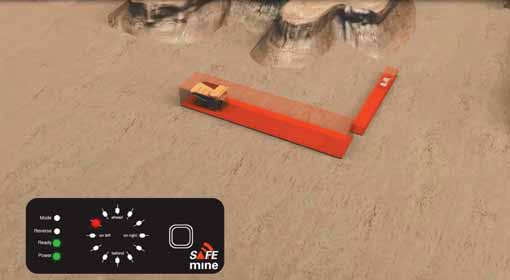 Providing 360° protection at any speed and any visibility with a typical range of 800 m, SAFEmine does not require
Providing 360° protection at any speed and any visibility with a typical range of 800 m, SAFEmine does not require
line of sight to function, and creates configurable zones around each vehicle.’
The technology increases situational
awareness and reduces accidents by
actively alerting the vehicle operator to
imminent threats. Speed, heading and
paths are calculated using GNSS to
determine the vehicle position, and are
sent via a radio link to other outfitted
vehicles in the area.
Two main functions are provided: traffic
awareness, which shows where other
vehicles are located, and collision warning,
which predicts if the paths of two
or more vehicles will converge. Audible
and visual warnings alert the drivers who
are causing the dangerous situation.
SAFEmine said its philosophy is to provide
the most effective information to the
operator so that he or she can make
informed decisions without being obtrusive
to their normal driving duties.
SAFEmine uses smart trajectory prediction
algorithms to minimize nuisance
alarms, and does not require any radio or
IT infrastructure. In addition to collision
avoidance, its product portfolio offers
fatigue monitoring, real-time fleet tracking,
solutions to avoid damaging cleanup equipment
around heavy rotating machines, and
radars to detect all objects (including personnel)
at ranges of up to 30 m. Operator
interfaces use sophisticated displays that
present vital information intuitively in truck
and other vehicle cabins.
Success stories are always better
to hear than accident reports, and
SAFEmine cited a recent example where
its CAS helped to avoid what could have
been a serious incident. A surveyor at
New Hope Group’s New Acland mine in
southern Queensland, Martin Leggat, told
of his experience: “I was driving along in
a light vehicle and came to an intersection,
looked both ways, and didn’t see
anything, so I started to accelerate. Then
SAFEmine CAS went off and alerted me
that a vehicle was coming and within a
second there was a big 793 dump truck
coming down on me—so the system basically
saved me,” he said.
Pulsed Radar Technology
U.S.-based Preco Electronics offers
PreView, which it described as being a
complete proximity-detection system that
provides rear, side and/or front active
blind-spot warning for mining machinery.
The company said its patented pulsed
radar technology is also used as a component
by other system vendors, and is
used by many OEMs in both factory installed
and retrofit applications.
PreView detectors can provide coverage
for distances of up to 10 m from
each sensor, with 360° coverage provided
by installing a number of sensors. The
system can be integrated with cameras
and monitors, while standard CAN-based
communications allow it to work with
third-party components such as GPS.
The company claims that PreView can
detect both moving and stationary
objects, is effective in extreme weather
and work-site conditions, and can be
fitted to equipment such as shovels,
ADTs, water trucks and loaders, as well
as haul trucks.
Preco provided E&MJ with an idea of
some of the costs involved following an
incident at a surface coal mine where an
operator accidentally reversed an empty
haul truck into the tail end of a shovel that
was loading on the other side. Not only
was the shovel badly damaged, but the
mine lost nine days of its use while it was
repaired. While the repair bill was some
$200,000, the total cost to the operation
was closer to $500,000 once standing
time for all the equipment was added in.
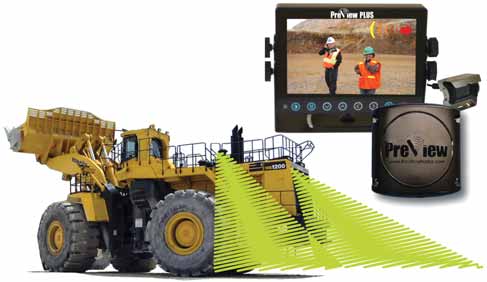 Preco Electronics’ PreView system provides rear, side and/or front active blind-spot warning for mining machinery.
Preco Electronics’ PreView system provides rear, side and/or front active blind-spot warning for mining machinery.
Its patented pulsed radar technology is also used as a component by other system vendors, and by OEMs in both
factory-installed and retrofit applications.
The mine subsequently installed
PreView radar, Preco said, giving the shovel
operator audible and visual notice of
the approximate range of an object in his
swing radius—with no further incidents
involving PreView-equipped vehicles.
Sensor Technology for Mining Vehicles
Sick AG is a major world producer of sensors
for industrial applications, with its
headquarters in Germany. In 2010, it
installed its first surface-mining CAS at
Alcoa’s Huntly bauxite mine in Western
Australia, marking the company’s introduction
of a family of turnkey proximity
and collision detection systems for the
OEM and retrofit market.
In a paper published two years ago,
Nicky Guenther, technical industry manager
for surface mining at Sick Australia,
and his colleague, Holger Salow, reported
that it was estimated that more than half
of the mining operations in Queensland
were trialing or operating proximitydetection
systems on heavy mining vehicles.
“Sadly,” they noted, “the majority
of fatalities in mines are still the result of
interaction between humans and mining
equipment,” before stating that, “the
varieties of accidents demand a combination
of technologies to assist operators
and reduce risk.”
Sick offers its Minesic100 system in
three formats: the TPS for large mining
trucks, the EPS for shovels, excavators
and draglines, and the WPS for wheel
loaders and wheel dozers. Where shovels
are concerned, the company pointed out
that the sequence of digging at the highwall,
slewing with a full bucket and loading
trucks can cause visibility to be
impaired because of huge blind spots
and dust, while the major hazard for
operators of wheel loaders and dozers is
the lack of visibility while reversing—a
maneuver that is repeated countlessly
during each shift.
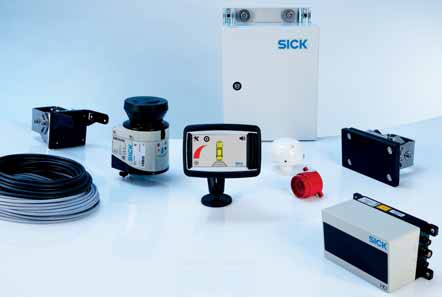 Sick offers its Minesic100 system in three formats: the TPS for large mining trucks, the EPS for shovels,
Sick offers its Minesic100 system in three formats: the TPS for large mining trucks, the EPS for shovels,
excavators and draglines, and the WPS for wheel loaders and wheel dozers.
In more detail, Minesic100 EPS for
shovels and excavators uses multilayer
and multi-echo laser scanner technology
to give the operator assistance in correct
vehicle positioning and safe hauler loading.
It provides active collision warnings
for the shovel operator and other heavy
vehicles, vehicle positioning and loading
assistance, and highwall collision warning.
Visual feedback is provided via a
touch-screen operator display and audible
alarms, and there is an open interface
to fleet management and dispatch systems,
and for event logging.
Meanwhile, Minesic100 WPS uses
advanced laser scanners and specialized
sensors to help wheel-loader operators
maneuver safely and efficiently. The system
gives full-coverage rear-end collision
warning, and can provide active reverse
assistance for maneuvering in confined
spaces while accurately displaying any
obstacles—including windrows, vehicles
and people—behind the vehicle in real
time. It is also fully functional across the
loader’s speed range, Sick noted.
The company stated that major benefits
from using its systems include fewer
incidents, less downtime and lower repair
costs, as they can detect and track moving
and stationary obstacles without the
need for RFID tags.
In all of the systems, unintended road
departure, potential collisions and reversing
incidents are prevented by alerting
the operator, with only the relevant information
displayed. Sick said that its CAS
has been developed to be an aid and not
an annoyance, as it has a built-in awareness
of intentional driving behavior, such
as avoiding a rock or turning at an intersection.
For trucks, it also automatically
adapts warning-zone dimensions according
to the vehicle’s speed, and switches
the context between reversing, traveling
forward, crossing roads, turning and
loading. A digital map is used to raise
the operator’s attention in his or her
approach to predefined hazardous areas
like intersections and construction sites.
The Fatigue Factor
Modular Mining Systems told E&MJ that
over the last 10 years, the mining industry
has become increasingly focused on
concerns related to operator safety; a
trend that prompted the company to
release its first-generation proximitydetection
system in 2006. Today,
Modular added, regulatory agencies and
mine organizations continue to strive for
a zero-incident workplace, a fact that has
mines placing even more emphasis on
both stand-alone and fleet-management
system-integrated safety solutions.
Modular stated that its safety management
tools meet this demand head-on
by addressing mines’ most common safety-
related issues: vehicle-to-vehicle collisions,
operator fatigue, hazard awareness,
speed violations and tire management.
Together, its collision avoidance
and fatigue management applications
form two of the pillars of its MineAlert
safety system.
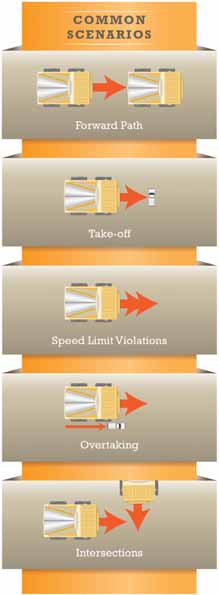 Five out of many potentially hazardous situations for
Five out of many potentially hazardous situations for
haul-truck operation that Modular Mining Systems
has identified.
The company’s CAS utilizes ranging
sensors and GPS receivers to determine
collision risks based on vehicle travel
paths, speed, distance and other factors.
A radio link provides direct vehicle-tovehicle
communication, eliminating the
need for wireless network infrastructure.
Today, its fourth-generation CAS addresses
more than 60 of the most common
vehicle collision scenarios, including forward
path (front-to-rear, head-on), takeoff,
speed-limit violations, overtaking and
intersections.
The module sends real-time notifications
of impending vehicle-to-vehicle collisions
to drivers via audible and visual
alarms. In contrast to systems focused
solely on proximity, the CAS distinguishes
between real and false safety threats,
thus virtually eliminating nuisance
alarms, Modular claims. “The collision
avoidance systems on the market today
suffer from a fatal flaw—they generate
excessive numbers of false alarms,” said
Michael Lewis, the company’s vice president
for product innovation. “Excessive
nuisance alarms cause operators to tune
out, thus reducing the effectiveness of
the system. Our fourth-generation collision
avoidance system is designed to predict
potentially hazardous situations
while minimizing nuisance alarms presented
to the operator.”
As a fully functioning stand-alone
application, Modular’s CAS has no
reliance or dependencies on external
applications or central servers. A dedicated
in-vehicle CPU stores sensor data,
which can be downloaded for use in
analysis reporting and training. When
integrated with a Dispatch fleet management
system, data are transmitted directly
to the central server for immediate and
future use.
Modular introduced its fatigue management
system to help mines combat
the issue of operator fatigue. Operators
receive a fatigue score, based on a number
of factors including their Circadian
rhythm patterns, quality of rest or sleep
before a shift, length and type of tasks
performed, and fatigue-based lapses in
steering. Purpose-built hardware employs
real-time, machine-behavior-based technology
to measure the dynamics of
equipped haul trucks and mine equipment.
The module combines the fatigue
score and equipment measurements to
predict the operator’s potential for risk
before fatigue actually occurs.
Assisting Operator Awareness
In mid-2013, Germany’s Becker Mining
announced a three-year global agreement
with ICAS Australia for the distribution
of its second-generation surface collision-
avoidance safety system. This uses
50-channel industrial GPS to detect the
position of all nearby mobile plant, vehicles
and fixed infrastructure that is also
fitted with an ICAS unit within a configured
zone, then uses a secure VHF wireless
network in conjunction with pre-configured
alarms to alert all surrounding
ICAS-fitted vehicles. Becker claims that
the system is accurate to plus-or-minus
1 m, and has a 20 km range, providing a
mix of audio and visual alerts as well as an
operator acknowledgement facility.
Becker’s national sales and marketing
manager, Jim Dwyer, said at the time: “the
primary objective is to keep personnel safe
and prevent damage to assets. With realtime
situational awareness essential to an
effective collision-avoidance system, ICAS
enhances operator awareness with critical
and accurate data—including vehicle orientation—
using a combined GPS-compass
heading sensor.
“This increases safety and minimizes
the chances of accidents or near-misses
resulting from insufficient reaction time
due to an operator’s lack of situational
awareness,” Dwyer added.
Heavy-duty Eyes All Around
Of course, proximity detection is not just
about being able to see other vehicles.
Simply reversing a mine truck at a wastedump
edge, or at a crusher, can have
its own challenges. The installation of
heavy-duty cameras is one solution that
gives the machine operator better rear
visibility. Intec Video specializes in producing
cameras for this type of application,
providing a range of high-resolution
color and black-and-white performance,
even down to 0.05 lux for very low-light
applications. Very wide-angle fields of
view are standard, the company said,
with narrower fields available for specific
machine requirements.
Intec’s systems include heavy-duty,
5- and 6.5- in. displays that are bracketor
flush-mountable for aftermarket or
customized OEM installation. System
controllers can handle up to five camera
inputs and two radar channels simultaneously,
with the option of multiview programming
for two-, three- or four-screen
viewing. Each camera channel can be
programmed individually, and all of the
camera views can be triggered automatically
as the machine is operated.
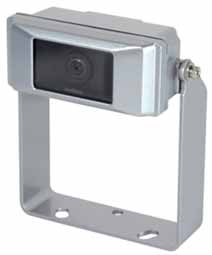 Intec’s heavy-duty cameras provide high-resolution
Intec’s heavy-duty cameras provide high-resolution
color and black-and-white performance, even in very
low light levels. Wide-angle fields of view are standard,
with narrower fields available if needed.
Intec said that its radar integration
safety system is redundant and independent
of the camera system’s visual
provisions. Radar integration includes a
visual, audible and secondary alert output
capability so that the radar alert will
still function fully if there is a loss of
video signal. And the company can provide
the cabling needed to connect all of
the system components, with its standard
type comprising heavy-duty polyurethane
jacketed cabling with overmolded
MIL-spec connectors. Both
armored and extreme temperature cables
are also available as options.
An Electromagnetic Approach
With a development program that has run
since the early 2000s, Strata Worldwide’s
HazardAvert is a very precise, near-field
proximity-detection system that discriminates
between actual or false intrusions
into warning zones, the company told
E&MJ. The system detects when a person
or vehicle enters the “marked zone”
around a piece of operating machinery.
When the zone is breached, it emits an
audible and visual alert to warn personnel
and vehicle operators of the imminent
danger.
HazardAvert uses a proximity module
to establish a magnetic marker field
around machinery to mark out areas that
are considered to be potentially dangerous.
Workers and operators wear a personal
alarm device (PAD), which detects
and measures the magnetic marker field
to determine their proximity from the
machine and alert them of possible danger
to their safety. Collisions between
machines can be avoided with the use of
vehicle alarm devices (VADs), which are
integrated with the proximity modules
and detect the electromagnetic fields of
other equipment.
According to Strata Worldwide, field
sizes and shapes can be configured and
customized to individual operations, and
can be shaped around a machine to cover
blind spots. The proximity module can
project an elliptical field up to 25 m from
its center, while the PAD and a personnel
warning module weigh just 90 g between
them—light enough to be worn on a safety
helmet or belt.
HazardAvert systems are activated
and deactivated by use of the brake or
retarder on a haul truck, and are temporarily
disengaged during truck loading
to eliminate nuisance alarms. The company
claims that the system is effective
over a greater range than others that are
available, providing coverage in the dark
and when operations are affected by dust
or bad weather.
An Essential Survival Tool
There is now increasing awareness of the
need for proximity detection and collision
avoidance technology in surface mining.
Indeed, industry take-up is accelerating,
with a number of national governments
now actively working toward mandatory
implementation of CAS in mining. In a
recently published white paper, GE
Mining noted that “In Australia, it is
widely accepted that discussions may
soon turn into forced compliance, with
Queensland’s commissioner for mine
safety and health listing investigation
into the use of CAS and proximity detection
technology as a key priority in its
2012-2013 report.
“From 2014, it is predicted to become
one of the top areas for planned technology
investment in Australian mining over
the next two years, with more than 30%
of Australian miners planning to invest in
the near future,” the company stated.
And as Sick AG noted, a number of
proximity detection systems are available
on the market, all of which are designed to
help save lives. No individual system offers
a “silver bullet” solution, as commented
by Queensland Senior Inspector of Mines
Tilman Rasche at a seminar on proximitydetection
systems in 2010, but they do
add a layer of protection to infrastructure,
equipment and people working in mines.
Detecting Overhead Danger
It is important to remember that sometimes proximity detection
needs to work vertically as well as along normal sight lines. The
British electronics company, Transport Solutions, has developed
a detector unit for one such potential hazard—high-voltage
overhead power cables.
Available in both in-cab and exterior-mounted versions, the
HVDS is designed to prevent vehicles and machinery from coming
into contact with overhead power lines. Consisting of a
detection antenna and an audio-visual warning unit, the system
can sense the presence of overhead power cables from up to
100 m away, warning the operator of the potential danger.
The company claims that the units can be mounted to virtually
any vehicle, with a simple “plug-and-play” setup procedure
that needs no calibration by the user.






